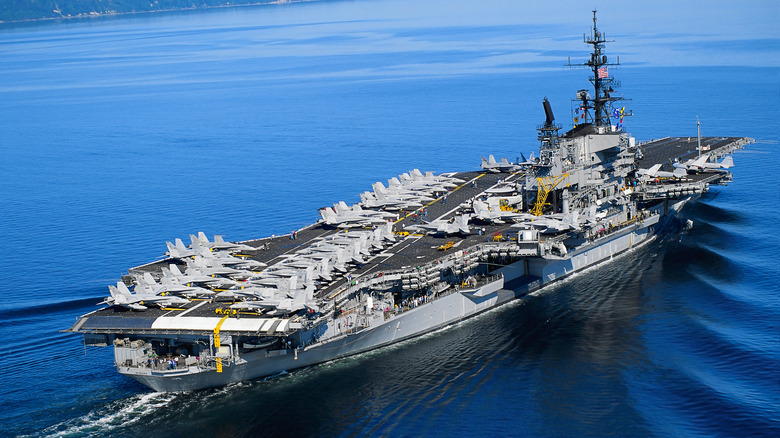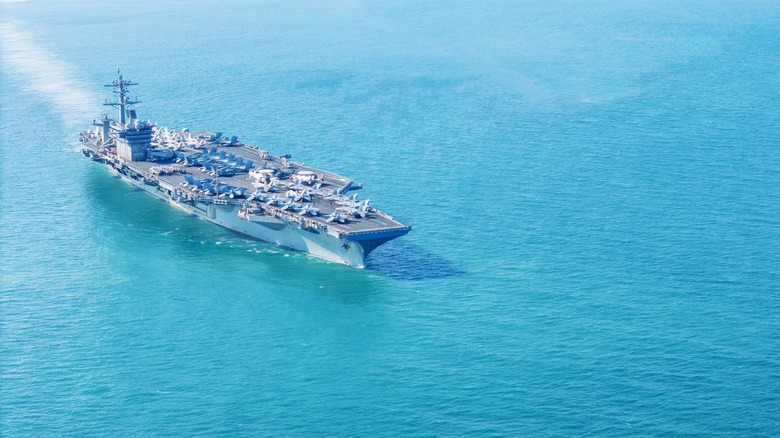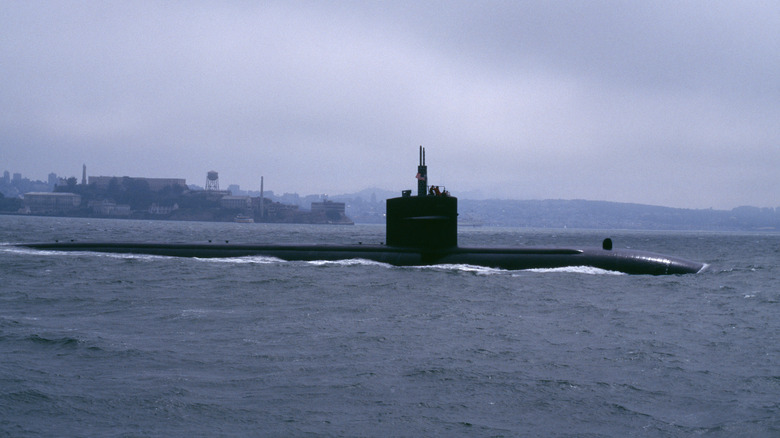US Navy Aircraft Carriers: What Does 'CVN' Stand For?
Many aircraft carriers, just like the one used in "Top Gun: Maverick," have hull classification codes that begin with CVN. The USS Abraham Lincoln is CVN 72, while USS Nimitz is CVN 68. If anyone were to believe that the United States military doesn't create anything without specific meaning, they would be wrong. It seems like common sense that vessel classifications are a combination of abbreviated words. After all, the F in F-22 stands for "fighter" because the F-22 is a fighter jet. Just as the B in B-2 Spirit stands for "bomber" because it's a bomber. However, it's not so cut and dry when it comes to aircraft carriers.
The words that CVN stands for have been debated by historians for decades. Contrary to popular belief, "CV" doesn't stand for carrier vessel. For a time, it was believed that the "C" stood for Cruiser, since early carriers were a part of the cruiser group of designations. The consensus today is that it does stand for "carrier." The "V," however, simply refers to fixed-wing aircraft, meaning jets. There's not a specific word for it, but if the V stands for anything, it's volplane, a French verb that means "gliding flight."
It's commonly used in the U.S. Navy when referring to "heavier-than-air" aircraft like fighter jets, bombers, and helicopters — as opposed to "lighter-than-air" vessels like blimps. What there isn't any debate about is the "N" in CVN. That definitively refers to the nuclear reactor on the aircraft carrier.
What does it mean to be a nuclear aircraft carrier?
No, being a nuclear aircraft carrier doesn't mean the carrier is armed with nuclear warheads or any other form of nuclear weapon. And no, the CVN carriers aren't launching bombers armed with nuclear weapons, either. It simply means that the carrier runs on nuclear power. Any carrier with a CVN designation has a nuclear reactor onboard that uses heat energy to generate steam, which then turns a series of turbines. Those turbines both generate power for the ship's propeller and electricity for the rest of the carrier. It's a closed-circuit system, so when the steam cools and turns back into water, it's filtered back through the system to start over again.
Besides the radiation from the reactor, which is shielded to protect crew members, it's a relatively clean form of energy that cuts down on emissions. Most large vessels at sea use diesel engines and fuel, which account for nearly 3% of global carbon emissions. More importantly, nuclear aircraft carriers are expected to remain in service for close to 50 years and only require refueling once during their entire tenure. It's why the USS Nimitz (CVN-68) is the oldest aircraft carrier still in service.
The United States is in the process of replacing the Nimitz-class carriers with its new Ford-class aircraft carrier, a process that won't be complete until 2050. There are currently five Ford-class carriers in the fleet, but there are plans to construct up to 11 in total.
Other nuclear-powered Navy vessels
The United States Navy employs more nuclear vessels than just aircraft carriers. Five of the most advanced submarines in the world are nuclear submarines, two of which are American. The hull designation for a nuclear submarine is SSN. Thanks to their nuclear reactor, these submarines don't need to pull into port until they need to replenish their food stores. If it wasn't for that, they could remain out at sea indefinitely. Unlike aircraft carriers, though, some nuclear submarines are also armed with nuclear-tipped warheads.
14 of America's Ohio-class submarines, for example, are ballistic missile submarines that carry nuclear weapons. A nuclear submarine is the ideal vessel to carry such powerful weapons because they're great at staying off the radar, or sonar, and rarely need to come ashore. They play hide-and-seek on a global scale.
Historically, there have also been nuclear-powered cruisers in the U.S. Navy, such as the USS Arkansas (CGN-41) with the hull designation CGN. These cruisers have since been decommissioned, with the last one exiting service in the late 1990s.


